A stele is the central cylinder or core of vascular tissue in higher plants and Pteridophytes. It consists of the xylem, phloem, pericycle, medullary rays, and pith if present.
The term stele has been derived from a Greek word meaning rod or column. Van Tieghem and Douliot (1886) introduced this term and put forward the stelar theory. The theory suggests that the cortex and the stele are the two fundamental parts of a shoot system. Both these components (stele and cortex) are separated by endodermis.
Types of Stele
Tieghem and Duoliot recognized only three types of steles. They also thought that the monostelic shoot was rare in comparison to polystelic shoots.
But now it is an established fact that most shoots are monostelic and polystelic condition rarely occurs. The stele of the stem remains connected with that of the leaf by a vascular connection known as the leaf supply.
There are several types of stele found in pteridophytes which are:
- Protostele
- Siphonostele
- Solenostele
- Dictyostele
- Polycyclic stele
- Eustele
- Polystele
1. Protostele
Jeffrey (1898), for the first time, pointed out the stelar theory from the point of view of the phylogeny. According to him, the primitive type of stele is protostele.
In protostele, the vascular tissue is a solid mass and the central core of the xylem is completely surrounded by the strand of phloem. This is the most primitive and simplest type of stele.
- Pith is absent in protostele i.e. it is non-medullated.
- The majority of the pteridophytes show protostelic conditions in their rhizome, stem, or roots.
There are five forms of protostele
- Haplostele
- Actinostele
- Plectostele
- Mixed Protostele
- Mixed Protostele with pith
(a) Haplostele
This is the most primitive type of protostele. Here the central solid smooth core of the xylem remains surrounded by uniform layers of phloem (e.g., in Selaginella spp., Gleichenia, Lycopodium).
- Named by Brebner in 1902.
- Usually present in fossil genera like Rhynia and Horneophyton.
(b) Actinostele
This is the modification of the haplostele and is somewhat more advanced in having the central xylem core with radiating ribs or arms (e.g., in Psilotum spp., Asteroxylon, Lycopodium serratum).
- Xylem is star-shaped or stellate, hence the name.
- The phloem is not present in a continuous manner.
- Phloem occurs as separate patches between the arms of the xylem.
- Named by Brebner in 1902.
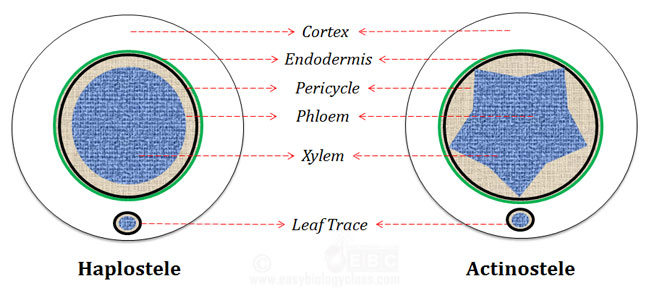
(c) Plectostele
This is the most advanced type of protostele. Here the central core of the xylem is divided into a number of plates arranged parallel to each other. The phloem alternates the xylem (e.g., in Lycopodium clavatum).
- Named by Zimmerman in 1930.
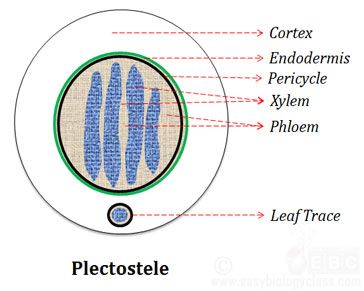
(d) Mixed protostele
Xylem is divided into several units or groups. Each xylem unit is scattered and arranged inside the groundmass of the phloem. Example: Lycopodium cernuum.

(e) Mixed protostele with pith
Here the xylem elements (i.e., tracheids) are mixed with the small patches of parenchymatous cells of the pith. This type is found in primitive fossils and living ferns. They are treated to be the transitional types in between true protosteles on the one hand and siphonosteles on the other (e.g., in Hymenophyllum demissum, Lepidodendron selaginoides, etc.).
2. Siphonostele
This is the modification of the protostele. A stele in which the protostele is medullated or with a pith at the center is known as siphonostele. Such stele contains a tubular vascular region and a parenchymatous central region i.e the central core of the pith is surrounded by the xylem.
- It is more advanced than protostele.
Origin of siphonostele
There are different views among scientists regarding the origin of siphonostele. But they all agreed that the siphonostele originated from protostele by the formation of a pith in the center. Here, the centrally placed xylem core is replaced with a parenchymatous pith.
Different stages of changing protostele to siphonostele can be observed in the T.S. at different levels in Gleichenia, Osmunda, and Anemia.
There are two views regarding the origin of pith in the siphonostele.
Jeffrey’s theory
According to this theory, the pith is formed as a result of the invasion of cortical parenchymatous cells into the stele. The invasion of the pith occurs through the leaf gap or branch gap.
Thus pith and cortex are homogeneous structures according to this theory.
This theory is not accepted by most of the authors since in many pteridophytes there is a stele without leaf gaps but having siphonostele.
Boodle’s theory
According to the theory proposed by Boodle (1901), and Gwynne Vaughan, the siphonostele has evolved from the protostele by a transformation of the inner vascular tissue into the parenchyma.
A siphonostele may be of the following types
(a) Ectophloic
In this type of siphonostele, the pith is surrounded by a concentric xylem cylinder, and next to the xylem the concentric phloem cylinder.
(b) Amphiphloic
In this type of siphonostele, the pith is surrounded by vascular tissue. The concentric inner phloem cylinder surrounds the central pith. Next to the inner phloem is the concentric xylem cylinder which is immediately surrounded by the outer phloem cylinder (e.g., in Marsilea rhizome).
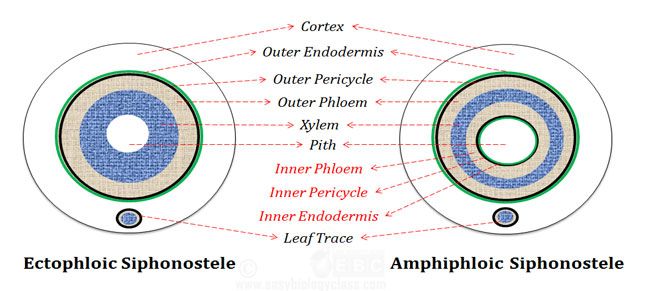
3. Solenostele
In solenostele, a pith is found with one leaf gap. It may be ectophloic or amphiphloic solenostele.
(a) Ectophloic: Xylem is surrounded only on the outer side by the phloem. E.g. in Osmunda.
(b) Amphiphloic: In the center, a pith is found. Xylem is surrounded on both sides by phloem. E.g. Marsilea rhizome.
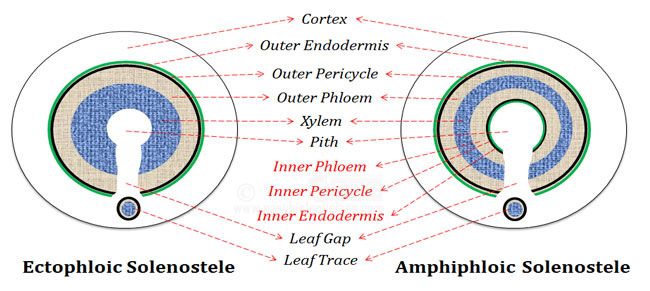
4. Dictyostele
Solenostele which is broken into a network of separate vascular strands is called dictyostele. This breaking up of the stelar core is due to the presence of a large number of leaf gaps.
Each such separate vascular strand is called a meristele. Each meristele is of protostelic type. The dictyostele with many meristeles looks like a cylindrical meshwork.
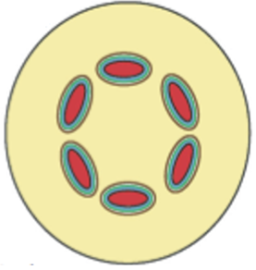
Examples: Pteris, Adiantum capillus-veneris.
5. Polycyclic Stele
This type of stelar organization is the most complex one among all vascular cryptogams (pteridophytes). Such types of steles is always siphonostelic in structure.
A typical polycyclic stele possesses two or more concentric rings of vascular tissue. This may be a solenostele or a dictyostele. Two concentric rings of vascular tissue are found in Pteridium aquilinum and three in Matonia pectinata.
(a) Polycyclic solenostele
(b) Polycyclic dictyostele

6. Eustele
According to Brebner (1902), there is one more modification of the siphonostele known as eustele. Here the vascular system consists of a ring of collateral or collateral vascular bundles situated on the periphery of the pith. An example of this type is the internode of Equisetum.
- It is the modification of the ectophloic siphonostele.
- Splitting takes place because of the overlapping leaf gaps.
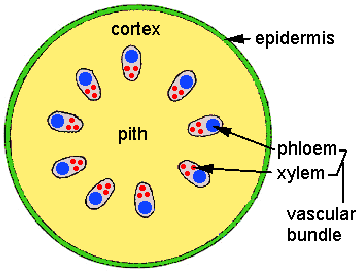
7. Polystele
More than one stele in the axis of pteridophytes is presently known as a playstyle. It is a type that must have derived from protostele because each such stele shows protostelic condition. In Selaginella kraussiana generally, two steles are present. But in Selaginella laevigata as many as 16 steles are present.

Other modifications of siphonostele
- Cladosiphonostele: No leaf gaps present. It is the simplest type of siphonostele. And found in several species of Selaginella.
- Phyllosiphonic siphonostele: Siphonostele that remains perforated by smaller or larger leaf gaps caused by leaf traces. Members of Filicophyta.
 Plantlet The Blogging Platform of Department of Botany, University of Dhaka
Plantlet The Blogging Platform of Department of Botany, University of Dhaka
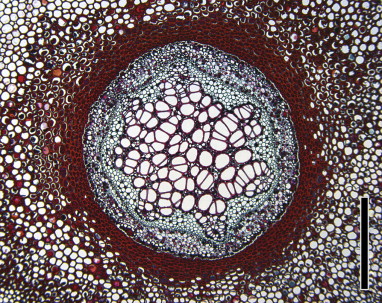

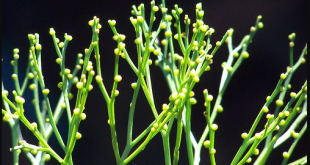
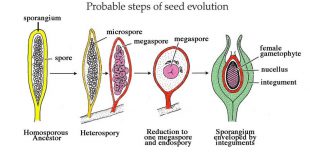
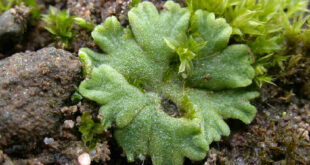

How can one get scholarships to go study in South Korea for Higher studies.
And yes…your content is wonderful…so useful..thank you so much 🤗😄 Good job 👏 👍
such a wonderful content! loved reading this